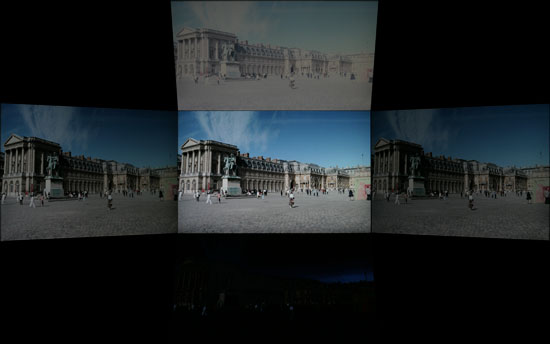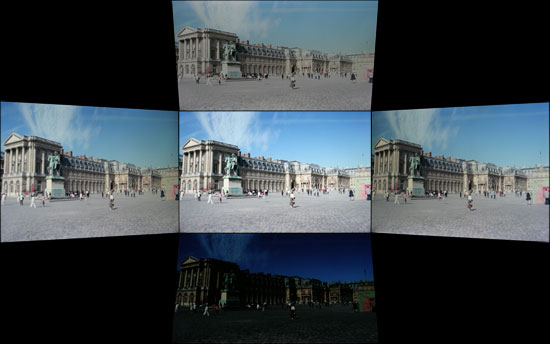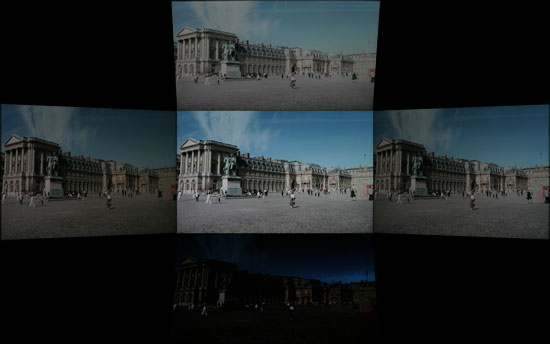Laptop LCD Roundup: Road Warriors Deserve Better
by Jarred Walton on May 22, 2007 5:00 AM EST- Posted in
- Displays
Viewing Angles
Viewing angles are one of those specifications that have become very inflated by the manufacturers. The basic requirement is that a display has to maintain a 10:1 contrast ratio in order to qualify as "viewable". The reality is that most LCDs are unfit for viewing outside of about a 45° arc, and on laptops you may not even get that much of a viewing arc. While we doubt that most people would want to view a display from an oblique angle, the typical positioning of a laptop - sitting on your lap only a couple feet from your eyes - can make viewing angles more important. Unfortunately, as all of the LCDs appear to use TN panels, that means viewing angles become more important and the technology becomes less satisfactory.
We used a Canon Digital Rebel SLR camera to take shots from head-on as well as from the left, right, top, and bottom at ~30° angles. We then combined the images into a single representative shot, showing how brightness and contrast ratios are affected in off-angle viewing. The camera was set to manual mode and an ISO value of 400 with an exposure time of 1/60s. While there's no substitute for actually sitting in front of a display yourself and using it, we did our best to use settings that generated images similar to what we saw in person. With all of the laptops photographed under the same conditions and with the same settings, the relative appearance of the images is at least as important as how each image looks individually.
Again, the ASUS G2P clearly comes out on top and offers the best overall viewing angles. The Dell XPS M1710 and MSI S271 are somewhat similar, though we would give the edge to the Dell laptop. The ASUS A8Js on the other hand ranks at the bottom, particularly in the areas of vertical viewing angles. On desktop systems, horizontal viewing angles are often more important, but in everyday use we find that vertical viewing angles are definitely a problem with many laptops. A slight tilt of your lap or a straightening of your back, and the perceived image can quickly become washed out.
Viewing angles are one of those specifications that have become very inflated by the manufacturers. The basic requirement is that a display has to maintain a 10:1 contrast ratio in order to qualify as "viewable". The reality is that most LCDs are unfit for viewing outside of about a 45° arc, and on laptops you may not even get that much of a viewing arc. While we doubt that most people would want to view a display from an oblique angle, the typical positioning of a laptop - sitting on your lap only a couple feet from your eyes - can make viewing angles more important. Unfortunately, as all of the LCDs appear to use TN panels, that means viewing angles become more important and the technology becomes less satisfactory.
We used a Canon Digital Rebel SLR camera to take shots from head-on as well as from the left, right, top, and bottom at ~30° angles. We then combined the images into a single representative shot, showing how brightness and contrast ratios are affected in off-angle viewing. The camera was set to manual mode and an ISO value of 400 with an exposure time of 1/60s. While there's no substitute for actually sitting in front of a display yourself and using it, we did our best to use settings that generated images similar to what we saw in person. With all of the laptops photographed under the same conditions and with the same settings, the relative appearance of the images is at least as important as how each image looks individually.
 ASUS A8Js  ASUS G2P  Dell XPS M1710  MSI S271 |
| Click to enlarge |
Again, the ASUS G2P clearly comes out on top and offers the best overall viewing angles. The Dell XPS M1710 and MSI S271 are somewhat similar, though we would give the edge to the Dell laptop. The ASUS A8Js on the other hand ranks at the bottom, particularly in the areas of vertical viewing angles. On desktop systems, horizontal viewing angles are often more important, but in everyday use we find that vertical viewing angles are definitely a problem with many laptops. A slight tilt of your lap or a straightening of your back, and the perceived image can quickly become washed out.










55 Comments
View All Comments
Myrandex - Tuesday, May 22, 2007 - link
I am not all that opposed to lower resolution screens when it comes to a laptop. Laptop video chipsets are often times slow enough as it is, and when my 7200 G0 64MB (256MB TC) is attempted to be used for gaming, 1280x800 gives a much better experience then some 1980x1600 breatly resolution.MrPickins - Tuesday, May 22, 2007 - link
4 screens, and not a single one a 15" model? How does that constitute a "roundup"?This article needs far more models tested to be worthwhile.
JarredWalton - Tuesday, May 22, 2007 - link
It's a roundup of what we have right now. I have some 15" laptops coming for review, and if this wasn't made clear we will be performing these same tests on all future laptop reviews. This was just a way to jump start things before the laptops we currently have are sent back.MrPickins - Tuesday, May 22, 2007 - link
Don't get me wrong, I like the article's intent, and the tests run. I just feel it would have been better to wait and give a large comparison all at one time, rather than piecemeal.EarthsDM - Tuesday, May 22, 2007 - link
Great article. If you guys wouldn't mind, could you do these tests to the MacBook and MacBook Pro? In light of this new lawsuit (see below) I'd like to know how good my MacBook Pro's display is, i.e. 6-bit or 8-bit. Thanks!http://arstechnica.com/journals/apple.ars/2007/05/...">http://arstechnica.com/journals/apple.a...it-over-...
http://www.appledefects.com/?p=282">http://www.appledefects.com/?p=282
heulenwolf - Tuesday, May 22, 2007 - link
Great job on the article. I had no idea the G2P's display was so demonstrably superior to the competition. I'd be interested to see these tests performed with two more variables:1) How do screen options within a single laptop model score? For example, if you get a Dell Inspiron with the default screen vs the upsell for the "Ultrasharp" model. Such a comparison could also give you two systems that are alike in every other way so you could discern the impact of the "better" screen on battery life
2) I always hear about how Macs are better for multimedia applications. Does the colorimeter and software work with Macs, as well? If so, I'd be interested to see whether their color accuracy is truly better than those of competing laptops.
strikeback03 - Tuesday, May 22, 2007 - link
I'd assume you could test the colorimeter on a Mac running Windows, shouldn't affect the screen quality.bldckstark - Wednesday, May 23, 2007 - link
Apparently recent testing on the Mac's have shown that the display performs better under Windows than OSx. This is one of the reasons they are being sued right now for claiming better visual representation than "regular" notebooks, when they appear to be the same as all the rest.I don't know anyone who has a Macbook, Pro or not so I have not seen this.
I have been on the edge of buying a Macbook for some time, but when push came to shove, I bought a Lenovo. It is hard to find someone (now I am sure millions will reply since I said this) that thinks the other manufacturers are even in the same league as IBM was. So far Lenovo has been doing a good job of keeping the Thinkpad up to snuff, so I couldn't reasonably spend my money on something I had never seen before and had no consistency in manufacturing from one model to the other. Besides, there is that keyboard 8^)
jelifah - Tuesday, May 22, 2007 - link
This article was TREMENDOUSLY helpful. As most laptops are bought online it is impossible to be able to determine what an LCD looks like, short of going to a company's kiosk.Please continue to do reviews like this.
mostlyprudent - Tuesday, May 22, 2007 - link
Agreed. It's about time someone included one of the most important part of a laptop in the review process. I also appreciated the comparison to desktop LCDs. I have been sticking with my CRT, in part, because of the stark difference in viewing quality between my laptop and desktop PCs.